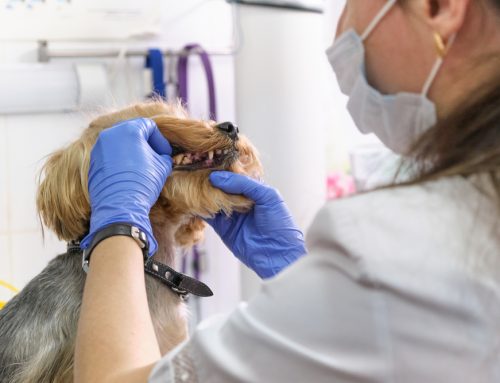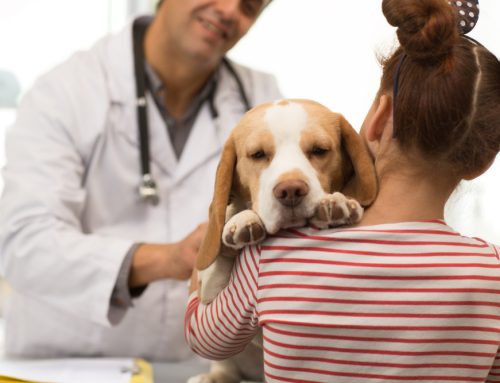Your pet’s dental health is more than white teeth and fresh breath—neglecting regular dental care can lead to unnecessary pain, periodontal disease, permanent organ damage, and a shortened lifespan for your pet. Fortunately, prevention is simple and effective. Preventive care at Westerville Veterinary Clinic and a consistent home care regimen can ensure your pet never suffers from this sneaky subgingival threat. Here are five action steps you can take every day to protect your pet’s dental health.
#1: Lift the lip—evaluate your pet’s dental health
By the time pets are 3 years old, more than 70% are experiencing early periodontal (i.e., dental) disease. Although your pet’s mouth might look OK to the naked eye, dental disease can be taking its toll below the gum line. Gingivitis (i.e., inflamed gums) is often the first sign of a larger problem, and may be quickly followed by visible tartar buildup and bad breath. Left untreated, dental disease signs will worsen to include:
- Visible tooth damage or fracture
- Heavy calculus (i.e., yellow or brown tartar)
- Chewing on one side of the mouth
- Facial swelling, or frequent rubbing and pawing
- Appetite changes
- Weight loss
- Reluctance to chew or play with toys
If a look below the lip reveals any periodontal disease signs, schedule an appointment at Westerville Veterinary Clinic for a comprehensive dental health assessment. Once periodontal disease is present, only a professional dental cleaning under anesthesia can restore your pet’s oral health. Don’t be fooled by the many retail products or anesthesia-free dentals that promise to clean teeth—remember, below the surface is what matters.
#2: Consult the professionals—your pet’s annual exam
Staying up to date on your pet’s yearly care should not be difficult, but sometimes life gets busy, and you forget to schedule their annual exam. You may choose to let it slide because your pet looks healthy, but missing a regular nose-to-tail assessment can prevent early diagnosis of many conditions, including periodontal disease.
If your pet is overdue for their yearly wellness exam, contact Westerville Veterinary Clinic. Each exam includes a thorough oral evaluation to identify inflammation, infection, or dental damage, and is followed by individualized recommendations for professional or at-home care.
#3: Give your pet a fresh start—schedule a dental cleaning under anesthesia
Regardless of your pet’s dental health status, we recommend a comprehensive oral health assessment and treatment (i.e., dental cleaning) at least every other year. Routine dental procedures will prevent or minimize periodontal disease’s negative effects, protect your pet from the pain and misery of broken or infected teeth, and save your pocketbook from costly dental extractions or surgery in the future.
At Westerville Veterinary Clinic, dentistry is more than cleaning. Your pet’s comprehensive care includes:
- Full-mouth digital dental X-rays — These are the gold standard for dental health. X-rays are the only way to look below the gum line, and assess each tooth root and surrounding bone.
- Oral cavity exam — Pets don’t exactly open up and say “Ah,” so while they’re under anesthesia, our veterinarians evaluate each tooth and look for any other oral abnormalities, including cancer.
- Cleaning and polishing — Every tooth is completely cleaned and polished above and below the gum line, to remove tartar, plaque, and bacteria.
- Extractions — Dental X-rays inform the veterinarian’s decision to remove any affected or diseased teeth.
- Pain management — Your pet will receive pain medication before, during, and after any uncomfortable procedures.
#4: Brush up—bringing pet dental care home
Caring for your pet’s teeth at home may sound impossible, but selecting the method that works best for you, your pet, and your schedule make a big difference in preventing or slowing periodontal disease. Although daily toothbrushing with an enzymatic pet toothpaste is the most effective way to prevent plaque and tartar, not every pet—or owner—is keen on the process. Fortunately, other effective options are available, including:
- Dental diets — Dental pet foods are designed to encourage thorough chewing, and their fibrous texture scrubs teeth and breaks down plaque.
- Water additives — Odorless and tasteless antibacterial water additives can deter plaque buildup with every sip.
- Dental chews — Dental chews are typically pliable, allowing your dog’s teeth to sink in for maximum scrubbing action. We recommend using only products that carry the Veterinary Oral Health Council (VOHC) Seal of Approval.
#5: Chew-s wisely—select safe chews and pet toys

Is your dog’s toy box causing dental injury and disease? Inappropriate chews, bones, and hard plastic toys can lead to fractured teeth and excessive wear, and expose the tooth’s sensitive pulp chamber. As a simple rule of thumb, any toy or chew that you wouldn’t want to strike on your knee is too hard for your dog’s mouth.
Recognize your pet’s chewing habits (e.g., light, moderate, power chewer) and shop smart. Select toys and chews that are safe for teeth and gums—ideally something with a slight give, such as dental chews or natural rubber toys (e.g., Kong, Goughnuts, WestPaw). Remove toys that show excessive wear or breaking, and never allow or encourage your dog to retrieve sticks or rocks.
Daily decisions lead to lifelong pet comfort and health
Although the occasional professional intervention is necessary, the majority of your pet’s dental health is determined by simple everyday choices. Are you making time for your pet’s dental health? Call or contact Westerville Veterinary Clinic to discuss your pet’s dental care needs, or to schedule a dental consultation.







Leave A Comment